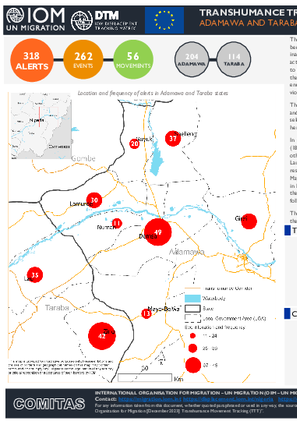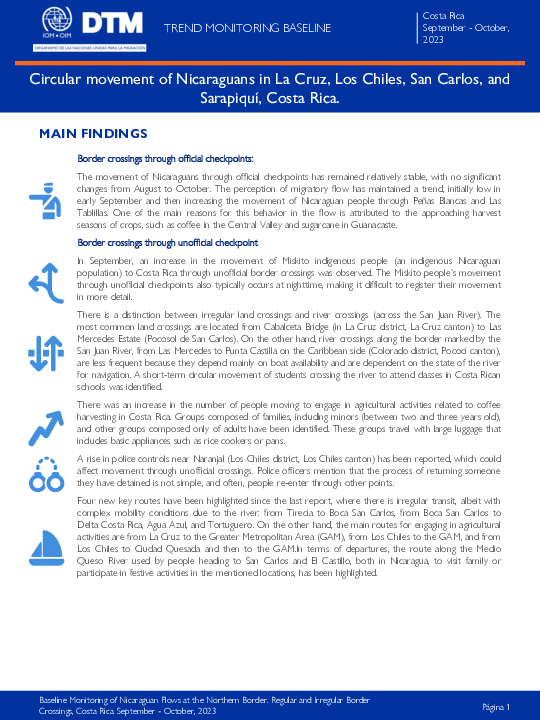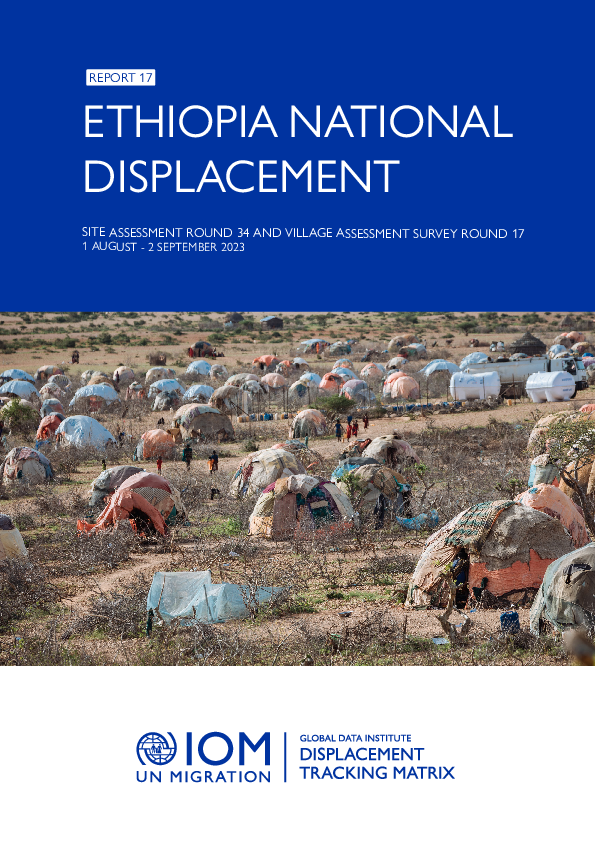-
Countries
-
Data and Analysis
-
Special Focus
-
Crisis Responses

Contact
DTM Europe, DTMMediterranean@iom.int
Language
English
Location
Latvia
Period Covered
Jul 01 2023
Sep 30 2023
Activity
- Survey
- Return Intention
Key Findings
- Top 3 countries of stay abroad: Poland (34%), Germany (21%), Russian Federation (15%)
- Oblasts of origin: Donetska (27%), Luhanska (21%), Zaporitzka (14%).
- Destinations in Ukraine: going to same oblast of origin (90%), to a different oblast (8%)
- Intentions after arrival to Ukraine: long-term stay (48%), short-term visit (24%), 28% do not know.
- Top needs on the way to Ukraine:* general information (84%), food supply (11%), short-term accommodation (2%).
- Top areas of assistance received:* financial support (92%), accommodation (70%), food (59%)
* more than one answer possible

Contact
DTM Burundi, DTMBurundi@iom.int
Language
English
Location
Burundi
Period Covered
Oct 01 2023
Nov 30 2023
Activity
- Survey
- Return Intention
Depuis 2020, la province de Bujumbura Rural, commune de Mutimbuzi, zone de Gatumba a été récurremment touchée par de fortes inondations affectant plusieurs milliers de personnes. Ces catastrophes naturelles ont engendré des déplacements massifs et la création de sites temporaires d'accueil à Kinyinya II et Sobel (Maramvya) afin de comprendre pleinement l'impact de ces événements et d'élaborer des stratégies de réponse adaptées, l'OIM a lancé une enquête de profilage en octobre 2023. Cette étude méticuleuse a permis de profiler 1 267 ménages déplacés, soit 3 889 personnes, dont certains ont depuis bénéficié d'une assistance pour retourner dans leurs foyers.
L'objectif de cette enquête était double : d'une part, évaluer les besoins immédiats des populations affectées pour orienter l'assistance humanitaire, et d'autre part, recueillir des données pour soutenir la planification à long terme en vue d'une résilience accrue face aux futures crises. Les résultats, qui seront présentés en détail dans ce rapport, révèlent non seulement l'étendue des défis auxquels sont confrontés ces ménages, mais aussi leur résilience et leurs perspectives d'avenir
Contact
DTM Ethiopia, DTMEthiopia@iom.int
Location
Ethiopia
Activity
- Mobility Tracking
- Village Assessment
Period Covered
Aug 01 2023 -Sep 02 2023
Between 01 August and 02 September 2023, IOM’s DTM deployed Site Assessment (SA) Round 34 and Village Assessment Survey (VAS) Round 17, carrying out a multisectoral location assessment. SA is conducted in locations hosting a reported 20 or more IDP households, and the VAS is conducted in locations hosting a reported 20 or more returning IDP households that returned after 1 January 2021. It is to be noted that Amhara region was largely uncovered this round due to increased insecurity, and both the IDP and returning IDP caseloads should likely be higher.According to the data collected through the Village Assessment Survey round 17 between August and September 2023, there were an estimated 2,530,101 returning IDPs (552,773 returning IDP households) across 2,072 assessed, accessible villages in Ethiopia. The highest returning IDP caseloads nationwide were in the regions of Tigray (1,503,141 returning IDPs, 59.41%), Amhara (an estimated 389,937 returning IDPs, 15.41%) and Afar (an estimated 222,894 returning IDPs, 8.81%).
Population Groups
Residents
Returnee (Previously Internally Displaced)
Survey Methodology
Unit of Analysis Or Observation
Admin Area 2
Admin Area 3
Admin Area 4
Community
Site or Location
Type of Survey or Assessment
Key Informant
Keywords
Geographical Scope Partial Coverage
Administrative boundaries with available data
The current dataset covers the following administrative boundaries
Contact
DTM Ethiopia, DTMEthiopia@iom.int
Location
Ethiopia
Activity
- Mobility Tracking
- Site Assessment
Period Covered
Aug 01 2023 -Sep 02 2023
Between 01 August and 02 September 2023, IOM’s DTM deployed Site Assessment (SA) Round 34 and Village Assessment Survey (VAS) Round 17, carrying out a multisectoral location assessment. SA is conducted in locations hosting a reported 20 or more IDP households, and the VAS is conducted in locations hosting a reported 20 or more returning IDP households that returned after 1 January 2021. It is to be noted that Amhara region was largely uncovered this round due to increased insecurity, and both the IDP and returning IDP caseloads should likely be higher.
According to data collected through the Site Assessment round 34 August and September 2023, an estimated 3,459,881 IDPs (701,449 IDP households) were internally displaced across 2,544 assessed, accessible sites in Ethiopia. Conflict is the primary cause of displacement and displaced 2.2 million IDPs (64.66%), followed by drought which displaced an estimated 612,250 IDPs (17.7%). Somali region hosts the highest number of IDPs primarily displaced by drought nationwide (an estimated 410,749 individuals or 67.1% of the national drought caseload), while Tigray region hosts the highest number of IDPs primarily displaced by conflict nationwide (an estimated 943,285 individuals or 42.2% of the national conflict caseload).
Population Groups
IDPs
Survey Methodology
Unit of Analysis Or Observation
Admin Area 2
Admin Area 3
Admin Area 4
Site
Type of Survey or Assessment
Key Informant
Keywords
Geographical Scope Partial Coverage
Administrative boundaries with available data
The current dataset covers the following administrative boundaries

Contact
dtmlebanon@iom.int
Language
English
Location
Lebanon
Period Covered
Oct 10 2023
Dec 19 2023
Activity
- Mobility Tracking
- Baseline Assessment
Since October 8 there has been an increase in cross-border incidents between Israel and Lebanon, resulting in the displacement of people both within the South and elsewhere within the country. Since October 10, the Displacement Tracking Matrix (DTM) has been conducting the daily monitoring of population movements. The objective of the exercise is to inform preparedness and response planning.

Contact
DTM Nigeria, iomnigeriadtm@iom.int
Language
English
Location
Nigeria
Period Covered
Nov 01 2023
Nov 30 2023
Activity
- Other
In November 2023, a total of 318 alerts were reported, comprising 262 events (82%) and 56 movements (18%). These reported events included farmer-herder conflicts, inter and intra-community tensions, and other incidents such as hippopotamus attacks on farms and residents in Shelleng LGA of Adamawa state. Lau and Zing LGAs in Taraba state recorded the highest number of alerts, with 19 and 17 per cent, respectively. Following closely were Demsa (16%), Shelleng (14%), Lamurde (9%), Girei (8%), Guyuk (8%), Mayo-belwa (5%), and Numan (4%). Disaggregated ward-level data suggested that Nassarawo Demsa ward in Demsa Local Government Area (LGA) of Adamawa state documented the highest number of alerts at the ward administrative level at 8 per cent. Monkin and Zing wards in Zing LGA of Taraba state are following closely with 5 per cent of reported event alerts.
The reported event alerts indicated a 1 per cent instance of population displacement, while 19 per cent of the alerts resulted in casualties or injuries.

Contact
dtmhaiti@iom.int
Language
English
Location
Haiti
Period Covered
Dec 18 2023
Dec 20 2023
Activity
- Mobility Tracking
- Event Tracking
On December 18th, armed attacks occurred in the city center of Ganthier, located in the 5th communal section of Pays Pourri, within the commune of Ganthier. This dashboard update provides the latest information on ETT 32.
These clashes resulted in the displacement of approximately 551 households, comprising a total of 2,740 individuals. The majority of the displaced people (71%) sought refuge with host families, while 29% settled in 4 sites situated in the 3rd communal section of Fond Parisien, within the same commune.

Contact
DTMCostaRica@iom.int
Language
English
Location
Costa Rica
Period Covered
Sep 01 2023
Oct 31 2023
Activity
- Flow Monitoring
- Mobility Tracking
- Event Tracking
Cantons: La Cruz, Upala y Los Chiles
The International Organization for Migration (IOM), the United Nations agency for migration in Costa Rica has implemented since 2021, two rounds of the Displacement Tracking Matrix (DTM) as part of its strategy to monitor the circular migratory flow of individuals of Nicaraguan nationality at unofficial border points in various cantons in the northern part of the country. Through this exercise at three unofficial entry points along the border with Nicaragua, a total of 60,697 migratory movements were recorded, of which 59 percent were departures and 41 percent were entries.
As a fundamental part of IOM's mission to provide key advice on migration policies and practices, it becomes necessary to update the data concerning this circular migration flow of Nicaraguans crossing both regularly and irregularly through the northern border of Costa Rica.
According to the records from the General Directorate of Migration and Immigration (DGME) regarding regular entries and departures through official border posts in Los Chiles and Peñas Blancas, in 2022, there were 394,730 regular migratory movements, of which 49.7 percent were entries and 50.3 percent were departures. From January to October 2023, a total of 419,925 movements were registered: 52 percent were entries and 48 percent were departures.

Contact
DTMCostaRica@iom.int
Language
Spanish
Location
Costa Rica
Period Covered
Sep 01 2023
Oct 31 2023
Activity
- Flow Monitoring
- Mobility Tracking
- Event Tracking
Cantones: La Cruz, Upala y Los Chiles
La Organización Internacional para las Migraciones (OIM), como agencia de las Naciones Unidas en materia de migración en Costa Rica, implementó, desde 2021, dos rondas de la Matriz de Seguimiento al Desplazamiento (DTM por sus siglas en inglés) como parte de su estrategia de monitoreo del flujo migratorio circular de personas de nacionalidad nicaragüense, en puntos fronterizos no oficiales, en distintos cantones del norte del país. A partir de este ejercicio en tres puntos de ingreso no oficial de la frontera con Nicaragua, se contabilizaron 60 697 movimientos migratorios, de los cuales el 59 por ciento fueron egresos y 41 por ciento ingresos.
Siendo parte fundamental de la misión de OIM brindar asesoría clave sobre políticas y prácticas migratorias, se vuelve necesario actualizar los datos de este flujo migratorio circular de nicaragüenses que cruzan tanto de forma regular como irregular la frontera norte de Costa Rica.
Según los registros de la DGME de ingresos y egresos regulares por puestos fronterizos oficiales en Los Chiles y Peñas Blancas, en 2022 hubo 394 730 movimientos migratorios regulares de los cuales el 49,7 por ciento fueron ingresos y 50,3 por ciento egresos, mientras que de enero a octubre de 2023 en total se registraron 419.925 movimientos: el 52 por ciento fueron ingresos y el 48 por ciento egresos.

Contact
DTM Ethiopia, DTMEthiopia@iom.int
Language
English
Location
Ethiopia
Period Covered
Aug 01 2023
Sep 02 2023
Activity
- Mobility Tracking
- Site Assessment
- Village Assessment
Between August and September 2023, IOM’s DTM deployed Site Assessment (SA) Round 34 and Village Assessment Survey (VAS) Round 17, carrying out a multisectoral location assessment. It is to be noted that Amhara region was largely uncovered this round due to increased insecurity, and both the IDP and returning IDP caseloads should likely be higher.
According to data collected through the Site Assessment round 34 August and September 2023, an estimated 3,459,881 IDPs (701,449 IDP households) were internally displaced across 2,544 assessed, accessible sites in Ethiopia. Conflict is the primary cause of displacement and displaced 2.2 million IDPs (64.66%), followed by drought which displaced an estimated 612,250 IDPs (17.7%). Somali region hosts the highest number of IDPs primarily displaced by drought nationwide (an estimated 410,749 individuals or 67.1% of the national drought caseload), while Tigray region hosts the highest number of IDPs primarily displaced by conflict nationwide (an estimated 943,285 individuals or 42.2% of the national conflict caseload).
According to the data collected through the Village Assessment Survey round 17 between August and September 2023, there were an estimated 2,530,101 returning IDPs (552,773 returning IDP households) across 2,072 assessed, accessible villages in Ethiopia. The highest returning IDP caseloads nationwide were in the regions of Tigray (1,503,141 returning IDPs, 59.41%), Amhara (an estimated 389,937 returning IDPs, 15.41%) and Afar (an estimated 222,894 returning IDPs, 8.81%).
